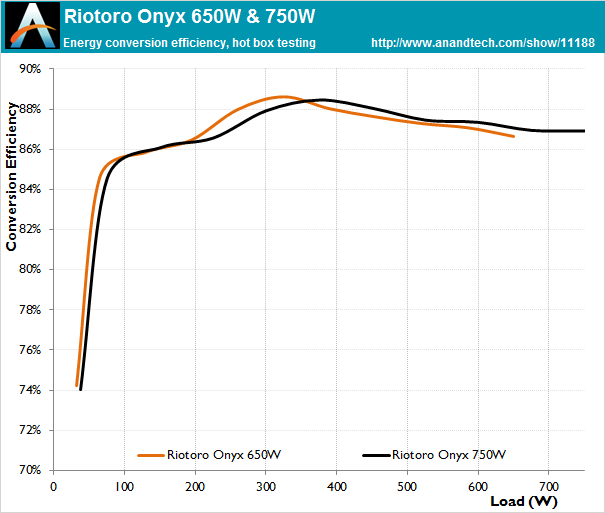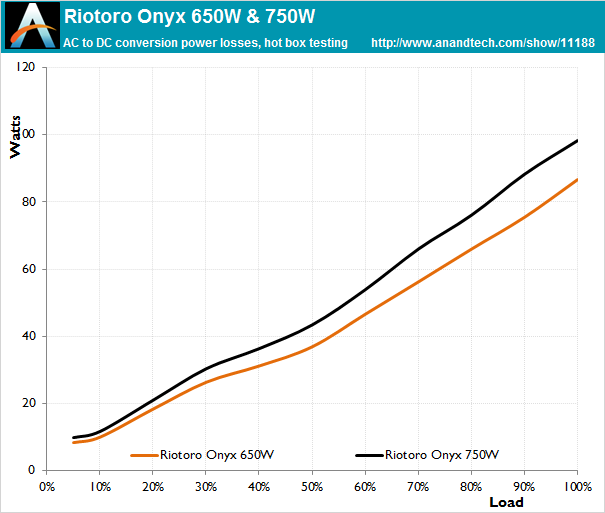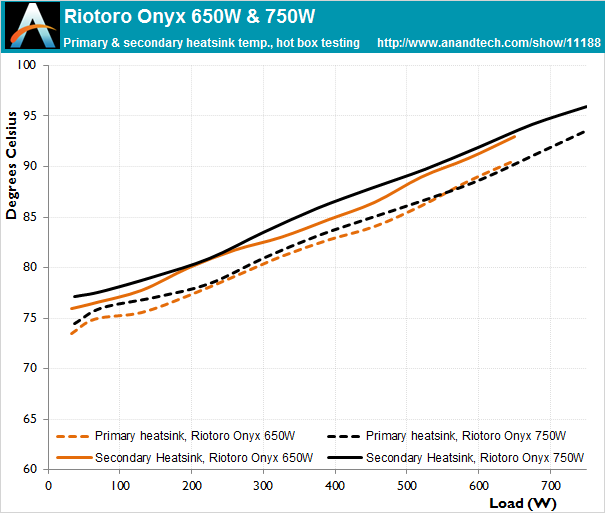The Riotoro Onyx Power Supply Review: 650W & 750W Tested
by E. Fylladitakis on March 23, 2017 10:00 AM ESTHot Test Results
Great Wall’s platform overall delivers a good power quality. As a matter of fact, the platform’s overall performance seems to have improved significantly since the last time we reviewed a similar unit, indicating that the OEM is candidly trying to improve.
| Riotoro Onyx 650W - Main Output | ||||||||
| Load (Watts) | 132.07 W | 329.14 W | 490.17 W | 652.48 W | ||||
| Load (Percent) | 20.32% | 50.64% | 75.41% | 100.38% | ||||
| Amperes | Volts | Amperes | Volts | Amperes | Volts | Amperes | Volts | |
| 3.3 V | 2.16 | 3.39 | 5.4 | 3.38 | 8.11 | 3.37 | 10.81 | 3.35 |
| 5 V | 2.16 | 5.13 | 5.4 | 5.12 | 8.11 | 5.08 | 10.81 | 5.05 |
| 12 V | 9.34 | 12.17 | 23.35 | 12.13 | 35.02 | 12.04 | 46.69 | 12.03 |
| Line | Regulation (20% to 100% load) |
Voltage Ripple (mV) | |||||
| 20% Load | 50% Load | 75% Load | 100% Load | CL1 12V |
CL2 3.3V + 5V |
||
| 3.3V | 1.4% | 8 | 12 | 16 | 24 | 10 | 22 |
| 5V | 1.5% | 8 | 16 | 20 | 30 | 16 | 26 |
| 12V | 1.2% | 16 | 30 | 44 | 52 | 68 | 26 |
We can see that the voltage regulation is significantly improved and very good for PSUs of this class and power range, at 1.2% on the 12V line and lower than 1.5% on the minor lines. The power quality readings are not going to break any performance records, but a maximum voltage ripple of 52 mV and 54 mV on the 12V line of the 650W and 750W models respectively is good, less than half that of the recommended design limit. Both units appear to be a little stressed when heavily cross loaded, with abnormally high ripple appearing on the 12V line, but the reading still do not go anywhere near the 120 mV design limit.
| Riotoro Onyx 750W - Main Output | ||||||||
| Load (Watts) | 152.2 W | 378.21 W | 565.85 W | 751.8 W | ||||
| Load (Percent) | 20.29% | 50.43% | 75.45% | 100.24% | ||||
| Amperes | Volts | Amperes | Volts | Amperes | Volts | Amperes | Volts | |
| 3.3 V | 2.2 | 3.38 | 5.49 | 3.36 | 8.24 | 3.36 | 10.98 | 3.34 |
| 5 V | 2.2 | 5.16 | 5.49 | 5.13 | 8.24 | 5.09 | 10.98 | 5.08 |
| 12 V | 10.98 | 12.15 | 27.45 | 12.08 | 41.18 | 12.05 | 54.9 | 12.01 |
| Line | Regulation (20% to 100% load) |
Voltage Ripple (mV) | |||||
| 20% Load | 50% Load | 75% Load | 100% Load | CL1 12V |
CL2 3.3V + 5V |
||
| 3.3V | 1.4% | 10 | 12 | 14 | 20 | 10 | 20 |
| 5V | 1.5% | 8 | 16 | 22 | 30 | 16 | 22 |
| 12V | 1.2% | 16 | 30 | 46 | 54 | 70 | 24 |
High ambient temperatures have a significant (but not abnormal) impact on the energy conversion efficiency of the Onyx 650W and Onyx 750W PSUs. The average nominal load range (20%-100%) efficiency drops by 0.7% for both units, with the drop almost evenly distributed across the load range, hinting that there are no component quality or stress issues. The nominal load range (20%-100%) efficiency is now 87.3% and, theoretically, both units sustain their 80Plus Bronze efficiency rating even under these operating conditions (the efficiency certifications are being performed with an ambient temperature of 25°C).
A quick glance on the sound pressure level charts shows that the noise levels of the Onyx units are unusually low for units with just an 80Plus Bronze rating. Both units are certainly going to be audible with a load greater than just 200 Watts under these operating conditions, but the noise levels of the fans only slightly surpass 46 dB(A) under maximum load, a relatively low reading taking into account the unit’s power output, efficiency and heatsinks. The reason for this is that the used fan is most likely slightly undersized for the cooling needs of these units, as the internal temperatures do reach uncomfortably high readings when the Onyx PSUs are heavily loaded under these working conditions.















32 Comments
View All Comments
Cellar Door - Wednesday, March 29, 2017 - link
Nobody cares that you had a PSU fail - there are plenty of new companies that make great products and there are plenty of old companies that make bad products.Aaannnndd nobody cares what you are going to do.
t4murphy - Sunday, March 26, 2017 - link
Same here. Been using my 750 silencer for 9 yrs. Couple SLI builds and MoBo no. 5 still going strongBrokenCrayons - Friday, March 24, 2017 - link
Aw, be nice to them. They get a lot of unwarranted abuse from people already.bigboxes - Friday, March 24, 2017 - link
Yeah, I bought a FSP (Fortran) 700 watt power supply in 2006 for my first dual core build. I could've swore that AnandTech had recommended the damn thing. Can't find a link to support that. Guess my memory is going. I tried out FSP as alternative when Antech was going through their QC issues. That PSU lasted maybe a year and then died in a puff of smoke. Was so pissed. Lot of money down the drain. I had bought a Seasonic PSU for my file server and liked it enough that I went to Seasonic for my main rig on my next build. I spend the money now for reliability as my boxes remain up 24/7. No more unknown cheap knock off brands for boxes.kn00tcn - Wednesday, March 29, 2017 - link
fsp is known to be one of the highest quality makers together with seasonic, both of them are suppliers to other brands like corsairyou people with your ignorance & single model failure stories that somehow represent an entire brand...
lefizz - Monday, March 27, 2017 - link
I bought a Tagan when they first came out probably based on the review. 18 months laters in took out my motherboard and cpu. Probably £400 worth of damage, luckily i was next to it when it failed or else i could have started a fire.On a side not i was working in an studio in London in the early 2000s and a few of the Dell workstations went up in smoke in spectacular fashion from damaged USB ports on the front. On one occasion one literally filled the studio with smoke in the 5 seconds it took for me to turn around and turn the machine off. It was a big studio, like a smoke bomb going off.
rocky12345 - Thursday, March 30, 2017 - link
I. had the same 700 watt Tagan was a great PSU. 2007-2014 I got my money's out of it. Heck it powered a Q6600@3.8Ghz Geforce 9800 GT ,Radeon HD 4870x2,Georce 580 & 680 GTX cards all overclocked over the years. What finally got it was a spider crawled into it and zap a flash of light and system went off.I took the cover off that's where I seen fried spider lol. I cleaned it up plugged it into a junker system and it worked fine. It worked two more years after the short out. Actually it still works I just upgraded to a newer unit. So either you got a bad unit or it was always running hot as the fans where small on those units. I was bummed when I found out they were gone.
DanNeely - Thursday, March 23, 2017 - link
BFG lasted from 2002 to 2010,when bought your card (2008 or later) they were a well established and highly recommended company at time; not an unknown upstart. And if their lifetime warranty was extravagant EVGA and XFX were both offering IIRC 5 years at the time. Both of the latter reduced theirs because of, and IIRC BFG was broken by, the rise of GPU compute and Crypto Coin mining resulting in much higher lifetime load times and consequently much higher than budgeted for failure rates.DanNeely - Thursday, March 23, 2017 - link
The really long warranties were also semi-supported for by nVidia insisting on card makers taking large numbers of low end GPUs to get full access to the premium parts. This stuck them with more budget cards than they could easily sell, a number of them were used up providing warranty replacements for similar performing older high end cards. eg my GTX6800 was replaced with a GT8500 when 3 or 4 years old.feelingshorter - Thursday, March 23, 2017 - link
I owned a BFG 6600GT and that dates back to 2005 and then bought a 8800GT as well, which was before compute or CUDA cores. Wasn't until the 8800GTX that CUDA cores even came on the market. I don't even remember any notable use for compute back then, even wikipedia says Bitcoin was founded in 2009 and earliest reviews for the 8800GTX was 2006. Feels like BFG failed due to the warranties because GPUs start to fail en mass right after 2 years more so than over usage of compute for mining.